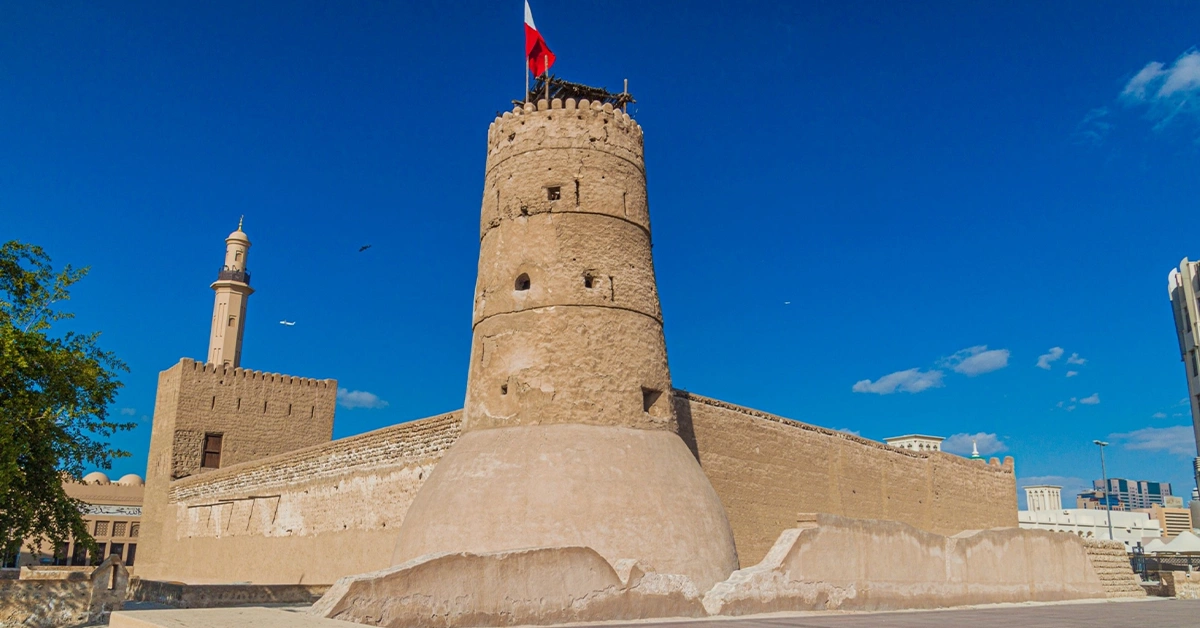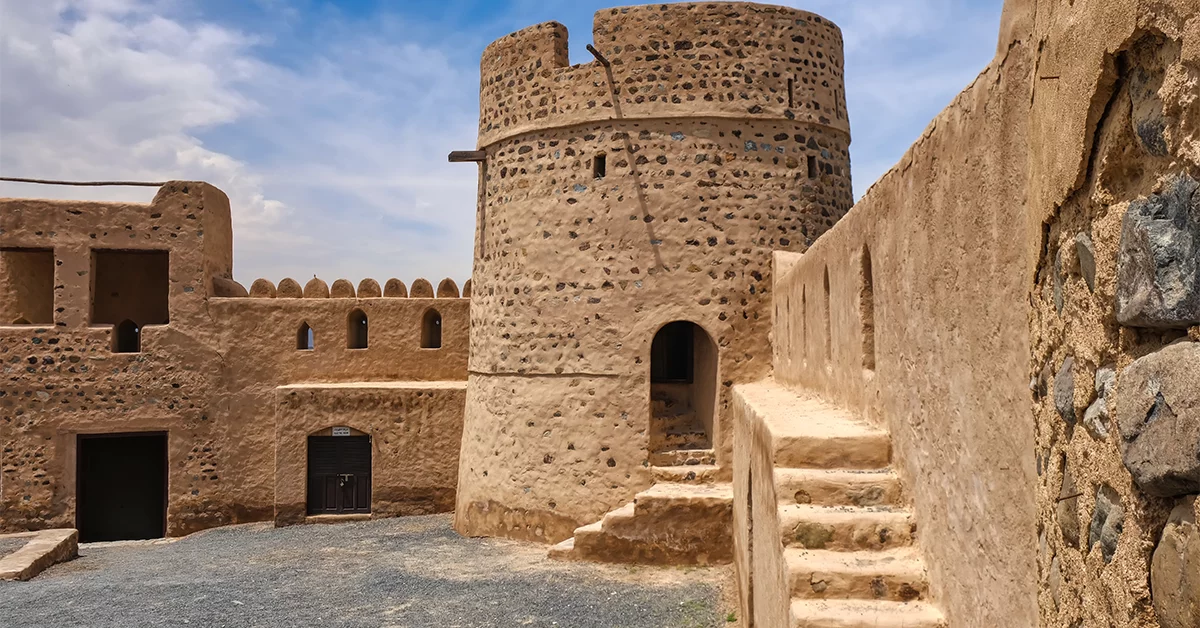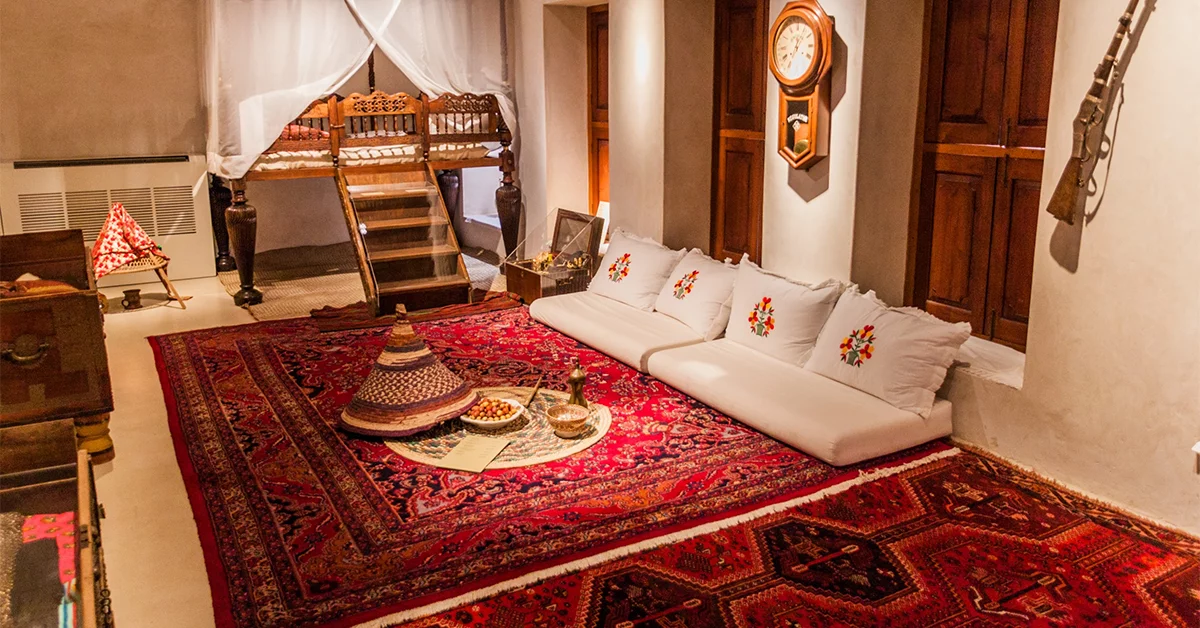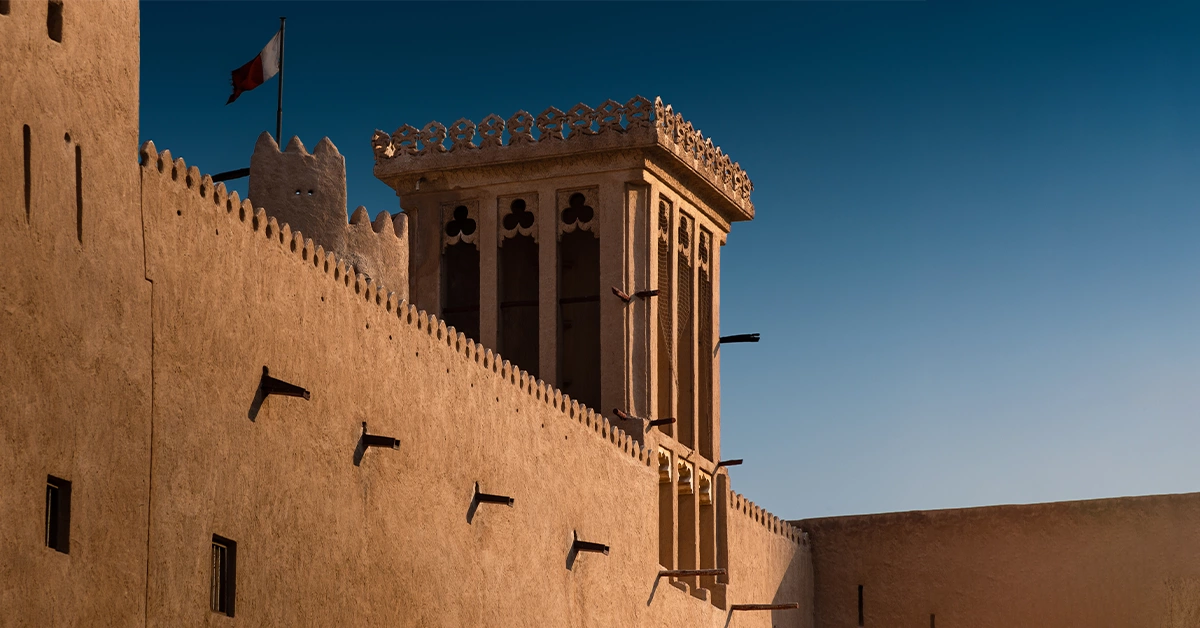The UAE is known for its contemporary cities, but there is also a rich history evident in its forts. These forts were previously constructed to defend towns, trade routes, and villages, and nowadays they remain as reminders of the nation’s past. From Qasr Al Hosn in Abu Dhabi to Dhayah Fort in Ras Al Khaimah, all the forts have their own history and beauty.
- Forts in Abu Dhabi
- Forts in Dubai
- Forts in Fujairah
- Forts in Sharjah
- Forts in Ras Al Khaimah
- Forts in Ajman
- Forts in Umm Al Quwain
- Key Takeaways
- FAQs
Forts in Abu Dhabi
Abu Dhabi boasts some of the UAE’s most well-known forts, demonstrating the culture and heritageof the emirate.

Qasr Al Hosn
Qasr Al Hosn is the city’s oldest and most symbolic building, initially constructed in the 1760s as a watchtower for the defence of the city’s freshwater well. The building transformed into a magnificent fort and then served as the residence of the ruling family, illustrating how the city matured from a small village to the current capital we have today.
Now, Qasr Al Hosn is a museum that shares Abu Dhabi’s history through old artefacts, exhibitions, and cultural events. Besides, you can walk through its restored walls, explore the Inner Fort and Outer Palace and enjoy workshops and festivals that bring Emirati heritage to life.
Location
Rashid Bin Saeed Al Maktoum Street, Al Hisn, Abu Dhabi, UAE
Timings
Saturday to Thursday: 09:00 am to 08:00 pm
Friday: 02:00 pm to 08:00 pm
Contact Information
+971-2-697-6400
Al Jahili Fort
Al Jahili Fort in Al Ain dates back to the late 19th century and is one of the largest forts in the UAE. With palm trees and gardens all around, alongside its sandy walls and soaring towers, it stands out as a tranquil and impressive spot to experience.
Additionally, it is a cultural venue where you can view exhibitions, watch art displays and unwind in the serene outdoor areas. It’s a family-oriented location that combines history with hospitality.

Location
Mohammed Bin Khalifa Al Nahyan Street, Al Jahili, Hai Al Qalaa, Abu Dhabi, UAE
Timings
Daily: 09:00 am to 07:00 pm
Contact Information
+971-3-711-8311
Forts in Dubai
Dubai has only one historic fort that reflects the city’s past and shows how it grew into a modern city.
Al Fahidi Fort
Al Fahidi Fort is the oldest fort in Dubai and is home to the famous Dubai Museum. In the heart of the Al Fahidi district, it reveals what daily life in Dubai looked like before the era of towering skyscrapers and contemporary living.
Inside Al Fahidi Fort, there are exhibits of older houses, old markets, trade, sea life and daily life in the past. It’s a fun and educational spot where both children and adults can learn about old Dubai.
Location
Al Fahidi, Dubai, UAE
Forts in Fujairah
Fujairah is known for its forts built in the mountains, which once protected villages and trade routes and still stand strong today.
Fujairah Fort
Fujairah Fort is one of the oldest and largest forts in the UAE, standing proudly on a hill overlooking the city. Built centuries ago with simple local materials, its sandy walls and tall towers are a great example of traditional Emirati architecture.
Around the fort, you’ll find old houses, a mosque and watchtowers that make it feel like a small heritage village. Climbing up gives you stunning views of Fujairah and the coastline, making it a spot where history and scenery come together beautifully.

Location
Al Sharyah, Fujairah, UAE
Timings
Daily: 08:00 am to 05:00 pm
Contact Information
+971-9-223-9201
Al Hayl Fort
Al Hayl Fort is tucked away in the mountains of Wadi Hayl, offering a peaceful escape surrounded by nature. Built in the early 20th century, it has a courtyard and watchtower that overlook the old village and rocky landscapes.
Besides, the area around the fort is full of history, with ancient tombs and carvings for the city’s ancestors. Visiting Al Hayl Fort feels like stepping back in time while enjoying the quiet beauty of the mountains.
Location
Al Hail Mountains, Fujairah, UAE
Timings
Saturday to Thursday: 08:30 am to 01:30 pm | 04:30 pm to 06:30 pm
Friday: 02:00 pm to 06:30 pm
Forts in Sharjah
Sharjah’s forts highlight the emirate’s history as a cultural and trading centre, preserving stories of its rulers and people.
Sharjah Fort (Al Hisn)
Sharjah Fort, also known as Al Hisn, is one of the city’s most important landmarks. Built in the early 19th century, it has been carefully restored and now stands proudly in the heart of Sharjah’s historic area. Its high walls and coral stone construction offer an insight into traditional design.
Nowadays, the fort is a museum where tourists can view galleries, former rooms, and exhibits related to the city’s rulers and past.

Location
Al Rolla Street, Al Ghuwair, Hay Al Gharb, Sharjah, UAE
Timings
Saturday to Thursday: 08:00 am to 08:00 pm
Friday: 04:00 pm to 08:00 pm
Contact Information
+971-6-568-5500
Kalba Fort
Kalba Fort is a charming coastal fort on Sharjah’s east coast, with roots dating back to the 18th century. Surrounded by mountains and offering stunning sea views, it has been recently restored and transformed into a museum for visitors to enjoy.
Right next to it is Bait Sheikh Saeed bin Hamad Al Qasimi, a traditional house that has also become a museum. Together, they create a small but rich heritage area where you can discover Sharjah’s past in a relaxed, scenic setting.
Location
Hay Alglah, Sharjah, UAE
Forts in Ras Al Khaimah
Ras Al Khaimah is home to several forts and watchtowers, each with its own history and style.
Dhayah Fort
Dhayah Fort is a unique hilltop fort in Ras Al Khaimah and the only one of its kind left in the UAE. Sitting high above the palm groves, it offers breathtaking views of the surrounding mountains, valleys and coastline.
Climbing up its steps is worth the effort, as you will see how it used to be, the area’s protective shield. At the bottom, you’ll also find older ruins and ancient tombs, making it a place where history and nature come together beautifully.
Location
Northern, Dhayah Fort, Al Rams, Ras Al Khaimah, UAE
Timings
Daily: 08:00 am to 07:00 pm
Contact Information
+971-7-233-8998
Al Falayah Fort
Al Falayah Fort is a quiet heritage site that was once home to the Al Qasimi rulers. It is best known as the place where the first peace treaties were signed in the 1820s, marking an important step in the UAE’s history.
The fort has a courtyard, mosque, and living quarters that show what life looked like in the past. Since visits are usually guided, the site feels calm and quiet, offering a more personal experience of Ras Al Khaimah’s heritage.
Location
Al Manama, Al Felyyah, Ras Al Khaimah, UAE
Timings
Open 24 Hours
Forts in Ajman
Ajman’s forts represent the humble yet robust heritage of the emirate, offering an intimate glimpse into traditional Emirati life.
Ajman Fort
Ajman Fort, constructed in the late 18th century, is among the emirate’s key landmarks. With its imposing barjeel (wind tower), the fort serves as a reminder of Ajman’s rich heritage.
The fort is home to Ajman Museum, which allows visitors to discover ancient weapons, manuscripts and displays reflecting the emirate’s traditional life. It is also located within the Ajman Heritage District, a cultural complex that bridges the city’s past and present.

Location
Al Bustan, Ajman, UAE
Forts in Umm Al Quwain
Umm Al Quwain’s forts stand as symbols of its history, from guarding the emirate’s rulers to preserving its farming and cultural traditions.
Umm Al Quwain Fort
Umm Al Quwain Fort, also called Al Ali Fort, was built in 1768 and stood as the centre of power in the emirate for two centuries. Its strong walls and traditional architecture reflect the history of the ruling family.
It is now occupied by the Umm Al Quwain National Museum, where you can view remnants from the ancient archaeological site as well as from displays that highlight the emirate’s culture and traditions.
Location
UAQ historical wall garden, Old Umm Al Quwain, Lamagdar, UAE
Falaj Al Mualla Fort
Falaj Al Mualla Fort was constructed in 1825 in the interior oasis of Umm Al Quwain. Flanked by watchtowers, the fort was created to safeguard the agricultural community and remains a symbol of the area’s heritage.
Now restored, the fort serves as a museum that highlights oasis life, including farming traditions, early poultry projects and the importance of date palms to the area’s history.
Location
Al Shareiah, Emirate of Umm Al Quwain, UAE
Timings
Saturday to Thursday: 08:00 am to 08:00 pm
Friday: 08:00 am to 12:00 pm | 02:00 pm to 08:00 pm
Contact Information
+971-6-748-5381
Key Takeaways
The forts across the UAE are important reminders of the country’s history and culture. Each of the emirates has its own forts that demonstrate how communities used to live, ranging from mountain villages to coastal towns. Most of these forts have been rehabilitated and turned into museums where visitors can view old artefacts, designs, and tales from earlier days.
Visiting these forts is not only about history, but also about seeing the distinctive personality of each emirate. From Abu Dhabi, Dubai, Fujairah, Sharjah, Ras Al Khaimah, Ajman or Umm Al Quwain, the forts speak to the rich heritage of the UAE and the path from humble beginnings to the nation it is now.
FAQs
Yes, they can. Most forts are open to visitors. Many have been restored and turned into museums, where you can see artefacts, exhibitions and traditional designs.
Forts are an important aspect of UAE history, indicating how people used to live, work and establish communities in the past. They also reflect the emirates’ cultural and architectural heritage.
The forts in the UAE are more than just old buildings; they are reminders of the country’s culture and history. Visiting them gives you a chance to learn about the past while enjoying the beauty and traditions of each emirate.
Furthermore, you can explore things to do in old Dubai on the Property Finder Blog.